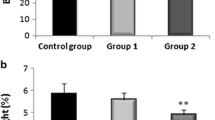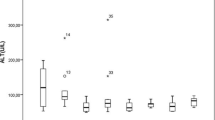Summary
Groups of female rats were treated orally with 0.5, 2.0, 8.0, and 32 mg/kg hexachlorobenzene twice a week for 203 days. The liver content of hexachlorobenzene was found to be dose-dependent. In the animals treated with the highest dose the concentration was 273 μg/g hexachlorobenzene. In the fresh and fixed hepatic tissue of the treated animals pink fluorescence was observed. Electron microscopy revealed a dose dependent enlargement of all hepatocytes due to proliferation of the SER in the centrolobular area or to increased glycogen deposits (β- or α-particles) and SER in the intermediary and periportal area. Numerous porphyrin deposits and siderosomes, intimate disorganisation and moderate dislocation of the RER and a moderate enlargement of bizarre-shaped mitochondria were recognized. The relationship between porphyrin crystals and mitochondria on the one hand and between SER and glycogen deposits on the other is discussed.
Similar content being viewed by others
References
Ashworth, C.T., Werner, J.D., Whrightsman, C.F.J.: Effect of thioacetamide-induced sublethal hepatic cell injury on protein synthesis. Proc. Soc. Exp. Biol. Med. (N.Y.)119, 495–501 (1965)
Bannasch, P., Papenburg, J., Ross, W.: Cytomorphologische und morphometrische Studien der Hepatocarcinogenese. I. Reversible und irreversible Veränderungen am Zytoplasma der Leberparenchymzellen bei Nitrosomorpholin-vergifteten Ratten. Z. Krebsforsch.77, 108–133 (1972)
Biempica, L., Kosower, N.S., Novikoff, A.B.: Cytochemical and ultrastructural changes in rat liver in experimental porphyria. I. Effects of a single injection of allylisopropylacetamide. Lab. Invest.17, 171–189 (1967)
Biempica, L., Kosower, N.S., Marcus, H., Goldfischer, S.: Hepatic porphyrias. Cytochemical and ultrastructural studies of liver in acute intermittent porphyria and porphyria cutanea tarda. Arch. Pathol.98, 336–343 (1974)
Cabral, J.R.P., Shubik, P., Mollner, T., Raitano, F.: Carcinogenic activity of hexachlorobenzene in hamsters. Nature269, 510–511 (1977)
Cam, C., Nigogosyan, G.: Acquired toxic porphyria cutanea tarda due to hexachlorobenzene. Jama183, 88–91 (1963)
Dittmer, D.S. (ed.): Handbook of toxicology. V. Fungicides, p. 19. Philadelphia and London: Saunders Co. 1959
Forssmann, W.G., Siegrist, G., Orci, L., Girardier, L., Pictet, R., Rouiller, Ch.: Fixation par perfusion pour la microscopie électronique. Essai de généralisation. J. Microsc. (Paris)6, 279–304 (1967)
Ghadially, F.N.: Ultrastructural pathology of the cell. London and Boston: Butterworths, 1975
Granick, S.: Chemical porphyria and acute porphyria. Proc. 9th Congr. Europ. Soc. Haematol. Lisbon 1963, pp. 596–603. Basel-New York: S. Karger, 1963
Koss, G., Koransky, W., Steinbach, K.: Studies on the toxicology of hexachlorobenzene. II. Idenfication and determination of metabolites. Arch. Toxicol.35, 107–114 (1976)
Kuiper-Goodman, T., Pontefract, R.D., Grant, D.L.: X-Ray (TEM) microanalysis of iron accumulated in liver parenchymal cells of rats with porphyria. Proc. Microsc. Soc. Canad.1, 14 (1974)
Kuiper-Goodman, T., Krewski, D., Combley, H., Doran, M., Grant, D.L.: Hexachlorobenzene-induced smooth endoplasmic reticulum in rat liver: A correlated sterologic and biochemical study. Proc. IV. Congr. Stereol. in NBS, pp. 351–354, Gaithersburg, Md., Sept. 4–9 (1975)
Kuiper-Goodman, T., Grant, D.L., Moodie, C.A., Korsrud, G.O., Munro, I.C.: Subacute toxicity of hexachlorobenzene in the rat. Toxicol. Appl. Pharmacol.40, 529–549 (1977)
Löwe, H.: Zur Bildung endoplasmatischer Membranen der Leberparenchymzelle in vitro. IV. Zum Nachweis von Membranbausteinen in “Glykogenkomplexen” der Leberparenchymzelle. Arch. Biol. Med. Germ.23, 887–906 (1969)
Medline, A., Bain, E., Menon, A.I., Haberman, H.F,: Hexachlorobenzene and rat liver. Arch. Pathol.96, 61–75 (1973)
Mollenhauer, H.H., Johnson, J.H., Younger, R.L., Clark, D.E.: Ultrastructural changes in liver of the rat fed hexachlorobenzene. Am. J. Vet. Res.36, 1777–1781 (1975)
Mollenhauer, H.H., Johnson, J.H., Younger, R.L., Clark, D.E.: A unique intracellular aberration related to hexochlorobenzene ingestion. Am. J. Vet. Res.37, 847–850 (1976)
Mukherjee, T., Gustavsson, R.G., Afzelius, B.A., Arrhenius, E.: Effects of carcinogenic amines on amino acid incorporation by liver systems. II. A morphological and biochemical study on the effect of dimethylnitrosamine. Cancer Res.23, 944–953 (1963)
Richardson, K.C., Jarett, L., Finke, E.H.: Embedding in epoxy resins for ultrathin sectioning in electron microscopy. Stain Technol.35, 313–323 (1960)
Scholnick, P., Marver, H.: The molecular basis of chloroquine (c) responsiveness in porphyria cutanea tarda (PCT). Clin. Res.16, 258 (1968)
Smuckler, E.A., Iseri, O.A., Benditt, E.P.: An intracellular defect in protein synthesis by carbon tetrachloride. J. exp. Med.116, 55–72 (1962)
Theodossiou, A., Bannasch, P., Reuss, W.: Glykogen und endoplasmatisches Retikulum der Leberzelle nach hohen Dosen des Carcinogens N-Nitrosomorpholin. Virchows Arch. Abt. B. Zellpath.7, 126–146 (1971)
Timme, A.H., Taljaard, J.J.F., Shanley, B.C., Joubert, S.M.: Symptomatic porphyria. Part II. Hepatic changes with hexachlorobenzene. S. A. Med. J.48, 1833–1836 (1974)
Venable, J.H., Coggeshall, R.: A simplified lead citrate stain for use in electron microscopy. J. Cell Biol.25, 407–408 (1965)
Villanueva, E.C., Jennings, R.W., Burse, V.W., Kimbrough, R.D.: Evidence of chlorodibenzo-p-dioxin and chlorodibenzofuran in hexachlorobenzene. J. Agr. Food Chem.22 (5), 916–917 (1974)
Waldo, E.D., Tobias, H.: Needle-like cytoplasmic inclusions in the liver of porphyria cutanea tarda. Arch. Pathol.96, 368–371 (1973)
Waterfield, M.D., del Favero, A., Palfrey, A.J.: Electron microscopic changes in the livers of mice treated with the porphyrinogenic agent 1.4-dihydro 3.5-dicarbethoxycollidine. J. Pathol.98, 151–154 (1969)
Watson, M.L.: Staining of tissue for electron microscopy with heavy metals. J. Biophys. Biochem. Cytol.4, 475–478 (1958)
Author information
Authors and Affiliations
Additional information
G.K. is supported by the Deutsche Forschungsgemeinschaft
The authors are indebted to S. Vellguth and J. Seidel for their technical assistance.
Rights and permissions
About this article
Cite this article
Böger, A., Koss, G., Koransky, W. et al. Rat liver alterations after chronic treatment with hexachlorobenzene. Virchows Arch. A Path. Anat. and Histol. 382, 127–137 (1979). https://doi.org/10.1007/BF01102869
Received:
Issue Date:
DOI: https://doi.org/10.1007/BF01102869




